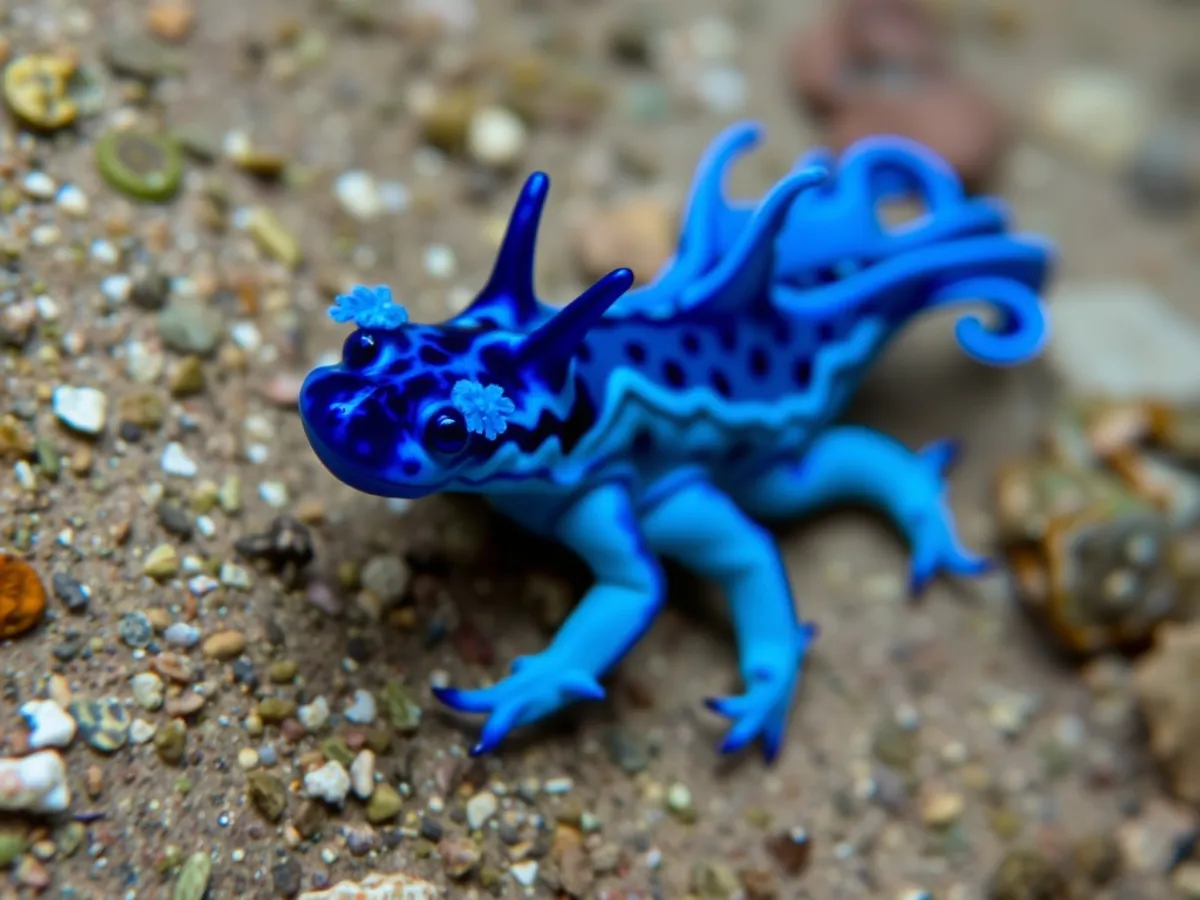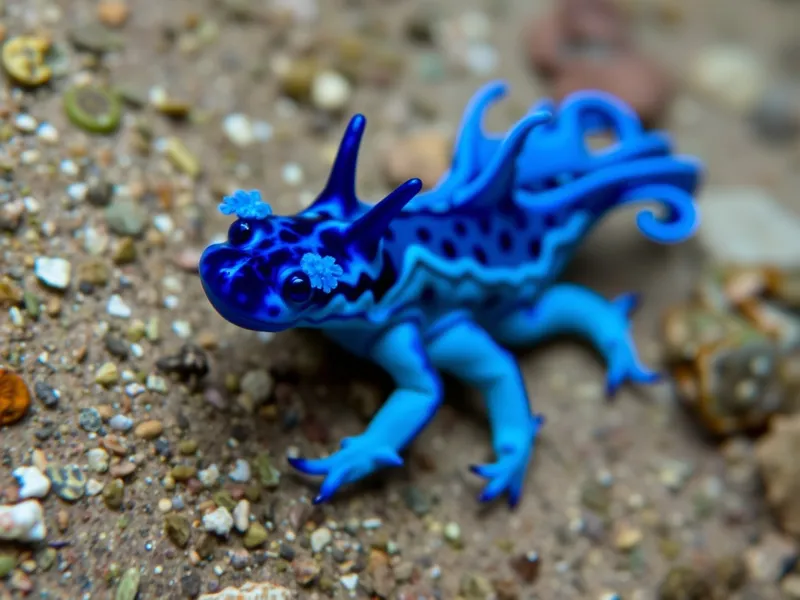
Blue dragon (sea slug)
Glaucus atlanticus

Meet the Blue dragon (sea slug)
The blue dragon (Glaucus atlanticus) is a strikingly colored species of small, pelagic sea slug found floating on the surface of warm ocean waters. Renowned for its iridescent blue and silver coloration, this nudibranch uses its unique appearance as camouflage against both predators above and below. It preys on venomous siphonophores such as the Portuguese man o' war, storing their stinging cells within its own tissues to use for its own defense. Despite its delicate, almost fantastical appearance, the blue dragon is a fierce carnivore and an expert drifter, traveling vast distances propelled by ocean currents.
Classification
Invertebrate
Habitat
Open ocean (pelagic zone), warm temperate and tropical seas
Diet
Carnivore
Lifespan
1 to 12 months
Conservation
Least Concern
Weight
3 to 10 grams
📖Fascinating Facts
Venom Thief
Blue dragons feed on venomous creatures like the Portuguese man o’ war and transfer the stinging cells to their own tissues for defense.
Ocean Drifters
They float upside down on the surface of the ocean, using surface tension and air stored in their stomachs to stay afloat.
Brilliant Camouflage
Their blue and silver coloration provides camouflage from both aerial and underwater predators—blue blends with the water from above, and silver with the sunlight from below.
📋Detailed Description
Glaucus atlanticus, commonly known as the blue dragon, is a small pelagic nudibranch that typically measures between 20 and 40 mm in length, though rare specimens may reach up to 60 mm. Its body is elongated, dorsoventrally flattened, and exhibits striking coloration: the dorsal side is a vivid blue with silvery undertones, while the ventral side is pale or silvery-grey, providing countershading camouflage against both aerial and aquatic predators. The blue dragon possesses six appendages, or cerata, which radiate laterally from its body and are used for both locomotion and defense. These cerata contain cnidosacs, specialized sacs that store nematocysts (stinging cells) acquired from its prey, particularly siphonophores such as Physalia physalis (Portuguese man o’ war). Unlike most nudibranchs, G. atlanticus is holoplanktonic, spending its entire life adrift in the open ocean, buoyed by a gas-filled sac in its stomach that allows it to float upside down at the water’s surface. Its mouth is equipped with strong jaws and radula adapted for piercing and consuming soft-bodied prey. The blue dragon exhibits simultaneous hermaphroditism, with both individuals exchanging sperm during mating. Its reproductive strategy includes laying long, gelatinous strings of eggs on floating debris or the carcasses of prey. Despite its delicate appearance, G. atlanticus is a voracious predator and displays remarkable resistance to the potent toxins of its prey, which it repurposes for its own defense. Its unique coloration and drifting lifestyle make it a subject of fascination for marine biologists and ocean enthusiasts alike.
💡 Did you know?
The blue dragon can consume and store the stinging nematocysts from the Portuguese man o’ war, making its own sting potentially even more painful than that of its prey.
🔬Research & Sources
🎭Behavior & Social Structure
Glaucus atlanticus is a solitary drifter, rarely aggregating except during periods of high prey abundance or when ocean currents concentrate individuals. It spends its life at the ocean’s surface, oriented upside down, with its blue dorsal side facing upward for camouflage against the sky and its silvery ventral side facing downward to blend with the sunlight from below. Feeding behavior is opportunistic and aggressive; it uses its radula and jaws to tear off pieces of prey, primarily siphonophores and other hydrozoans. The blue dragon is capable of consuming prey much larger than itself, and it selectively stores the most potent nematocysts in its cerata for defense. It exhibits little to no parental care, and after mating, individuals go their separate ways. Daily routines are largely dictated by ocean currents, wind, and prey availability, as the animal lacks active swimming ability and relies on passive drifting.
👶Reproduction & Life Cycle
Glaucus atlanticus is a simultaneous hermaphrodite, meaning each individual possesses both male and female reproductive organs. Mating typically occurs when two individuals come into contact, often belly-to-belly to avoid stings from each other's cerata. Copulation involves reciprocal exchange of sperm, after which both individuals are capable of laying eggs. The eggs are deposited in long, gelatinous strings on floating substrates such as driftwood, seaweed, or the remains of prey. Embryonic development is direct, with no larval stage; juveniles hatch as miniature versions of adults. There is no parental care post-oviposition. Breeding can occur year-round in suitable conditions, but peaks may correspond with increases in prey abundance, particularly during warm seasons.
🛡️Adaptations & Survival
The blue dragon exhibits several remarkable adaptations for pelagic life. Its countershaded coloration provides camouflage from both aerial and aquatic predators. The gas-filled sac in its stomach allows it to float at the surface, and its cerata increase surface area for buoyancy and serve as storage for nematocysts. Its resistance to potent toxins from siphonophores is a key evolutionary specialization, enabling it to exploit a niche few other predators can. The ability to sequester and redeploy nematocysts as a defense mechanism is a rare and highly effective adaptation. Its radula and jaws are specialized for piercing and consuming gelatinous prey. The upside-down orientation at the surface is unique among nudibranchs and enhances its camouflage and feeding efficiency.
📚Research Sources
🎨Cultural Significance
While Glaucus atlanticus does not have a prominent role in traditional human culture or mythology, its striking appearance has made it a subject of fascination in popular science, marine art, and social media. It is sometimes referred to as the 'blue dragon' or 'sea swallow,' invoking mythical imagery. Its ability to harness the venom of its prey has inspired comparisons to dragons and other legendary creatures. The species is occasionally featured in educational materials and public aquaria, though it is difficult to maintain in captivity. There are no known traditional uses or symbolic meanings in indigenous cultures.
🔬Recent Research & Discoveries
Recent research has focused on the mechanisms by which G. atlanticus sequesters and deploys nematocysts, with studies revealing specialized epithelial cells in the cerata that safely transport and store the stinging cells. Genetic studies have begun to elucidate the evolutionary relationships between Glaucus and other aeolid nudibranchs, highlighting convergent adaptations to pelagic life. Ongoing research is investigating the impacts of ocean warming and plastic pollution on its distribution and reproductive success. Notably, a 2022 study documented the presence of microplastics in the gut contents of stranded individuals, raising concerns about ingestion and bioaccumulation. Citizen science initiatives have contributed valuable data on global sightings and strandings, enhancing understanding of its range and population dynamics.
🎥Wildlife Videos

The Real Life Sea Dragon
Glaucus atlanticus, also known as sea slug, blue swallow, blue sea slug is a creature that looks like a sea dragon. For copyright ...
ZoneA

The Blue Dragon: Ocean’s Shimmering Mystery 🐉💙
Dive into the enchanting world of the blue dragon (Glaucus atlanticus)! This stunning, iridescent marine creature is like ...
Animals for Kids

Have you heard of The Blue Dragon in the sea?
Discover the mysterious Blue Dragon in the sea! This fascinating ocean creature is a must-see for any nature enthusiast or wildlife ...
GeneralDocumentary

True Facts: Freaky Nudibranchs
Cuz the ocean is weird. True Facts T-shirts: https://ze-true-store.myshopify.com/ Join https://www.patreon.com/truefacts CREDITS: ...
Ze Frank

This Adorable Sea Slug is a Sneaky Little Thief | Deep Look
Nudibranchs may look cute, squishy and defenseless ... but watch out. These brightly-colored sea slugs aren't above stealing ...
Deep Look

The Blue Sea Dragon - Animal of the Week
This week we look at Glaucus atlanticus, a very colourful kind of mollusc known as the Blue Sea Dragon. Join our Discord server: ...
Ben G Thomas
🌍Habitat Information
The Blue dragon (sea slug) typically inhabits Open ocean (pelagic zone), warm temperate and tropical seas environments. Blue dragon (sea slug)s have adapted to their environments with specialized features and behaviors.
Primary Habitat:
Open ocean (pelagic zone), warm temperate and tropical seas
More detailed habitat information will be available soon.
🛡️Conservation Status
The Blue dragon (sea slug) is currently classified as Least Concern. Conservation efforts are crucial for preserving this species for future generations.
Common Threats:
- 🏠Habitat loss and fragmentation
- 🌡️Climate change impacts
- 🎯Hunting and poaching
- 🏭Human-wildlife conflict
⚠️Threats & Conservation Challenges
Currently, Glaucus atlanticus faces few natural predators due to its potent chemical defenses, though some sea birds and fish may prey on it. Its primary threats are environmental: changes in ocean currents, pollution (especially plastics, which can be mistaken for floating substrate), and climate change, which may alter the distribution of its prey. There is limited data on population trends, but the species is currently listed as Least Concern by the IUCN. Human impact is generally minimal, though increased interest from collectors and beachgoers can pose localized risks. Mass strandings may occur after storms, leading to high mortality. Ocean acidification and habitat degradation could pose future challenges.
🔬Scientific Classification
Scientific Name
Glaucus atlanticus
Classification Hierarchy
🔍 About Taxonomic Classification
Taxonomic classification is a hierarchical system used by scientists to classify and organize living organisms based on shared characteristics and evolutionary relationships.
The system moves from broad categories (Kingdom) to increasingly specific ones, with each animal's scientific name typically consisting of its Genus and species.
📝Community Notes
Share your observations and insights about the Blue dragon (sea slug) with our community of wildlife enthusiasts.
Join Our Community
Sign in to share your observations and connect with fellow wildlife enthusiasts.
Sign In to ContributeNo community notes yet
Be the first to share your observations about the Blue dragon (sea slug)!
Explore Blue dragon (sea slug)
Select a tab above to learn more about this amazing animal.
📸Photo Gallery
No photos available for this animal yet.
🌟Discover More Wildlife
Continue your journey of discovery with more fascinating animals from our database
